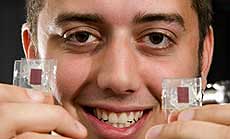
Plastic, Crystal-Based Solar Cells Being Developed
BRISBANE, Australia, Sept. 7, 2006 -- A University of Queensland researcher is developing ways to make the next generation of solar cells made out of plastics and microscopic crystals instead of silicon.
UQ master of physics student Michael Deceglie is working on improving the stability and overall efficiency of solar cells and is testing two new ways of making them: out of a dye-sensitized solar cell and a combined nanocrystal-polymer solar cell.
Deceglie with the dye-sensitized test solar cells.
The dye-sensitized cells use dye molecules to inject electrons into a thin titanium-dioxide film while the polymer cell is a thin film of plastic mixed with microscopic crystals that channel the charge through the cell, he said.
Deceglie said both methods could produce solar cells that had similar efficiencies to current silicon technology but are cheaper more flexible, easier to produce and more environmentally friendly.
“Since electrons don't move well in the polymers, we incorporate nanocrystals with the polymer to provide a pathway along which electrons can move to generate electrical current,” Deceglie said. “The dye-sensitized device works in a manner similar to phosynthesis in plants.”
Deceglie joined UQ's Soft Condensed Matter Physics Group in July as one of 14 Americans granted a Fulbright postgraduate award scholarship. Fellow UQ physics PhD students Paul Schwenn and David Blake are assisting with the solar cell project.
For more information, visit: www.uq.edu.au
Published: September 2006